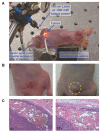Applications of functionalized fullerenes in tumor theranostics
- PMID: 22509193
- PMCID: PMC3326736
- DOI: 10.7150/thno.3509
Applications of functionalized fullerenes in tumor theranostics
Abstract
Functionalized fullerenes with specific physicochemical properties have been developed for cancer diagnosis and therapy. Notably, metallofullerene is a new class of magnetic resonance imaging (MRI) contrast-enhancing agent, and may have promising applications for clinical diagnosis. Polyhydroxylated and carboxyl fullerenes have been applied to photoacoustic imaging. Moreover, in recent years, functionalized fullerenes have shown potential in tumor therapies, such as photodynamic therapy, photothermal treatment, radiotherapy and chemotherapeutics. Their antitumor effects may be associated with the modulation of oxidative stress, anti-angiogenesis, and immunostimulatory activity. While various types of novel nanoparticle agents have been exploited in tumor theranostics, their distribution, metabolism and toxicity in organisms have also been a source of concern among researchers. The present review summarizes the potential of fullerenes as tumor theranostics agents and their possible underlying mechanisms are discussed.
Keywords: Functionalized fullerenes; cancer diagnosis; cancer therapy; nanoparticles; theranostics..
Conflict of interest statement
Conflict of Interest: The authors have declared that no conflict of interest exists.
Figures







References
-
- Kroto HW, Heath JR, O'Brien SC. et al. C60: Buckminsterfullerene. Nature. 1985;318:162–3.
-
- Bosi S, Da Ros T, Spalluto G. et al. Fullerene derivatives: an attractive tool for biological applications. Eur J Med Chem. 2003;38:913–23. - PubMed
-
- Kato H, Kanazawa Y, Okumura M. et al. Lanthanoid endohedral metallofullerenols for MRI contrast agents. J Am Chem Soc. 2003;125:4391–7. - PubMed
-
- Arbogast JW, Darmanyan AP, Foote CS. et al. Photophysical properties of C60. J Phys Chem. 1991;95:11–2.
-
- Liu Z, Kiessling F, Gatjens J. Advanced nanomaterials in multimodal imaging: design, functionalization, and biomedical applications. J Nanomater. 2010.
LinkOut - more resources
Full Text Sources
Other Literature Sources

